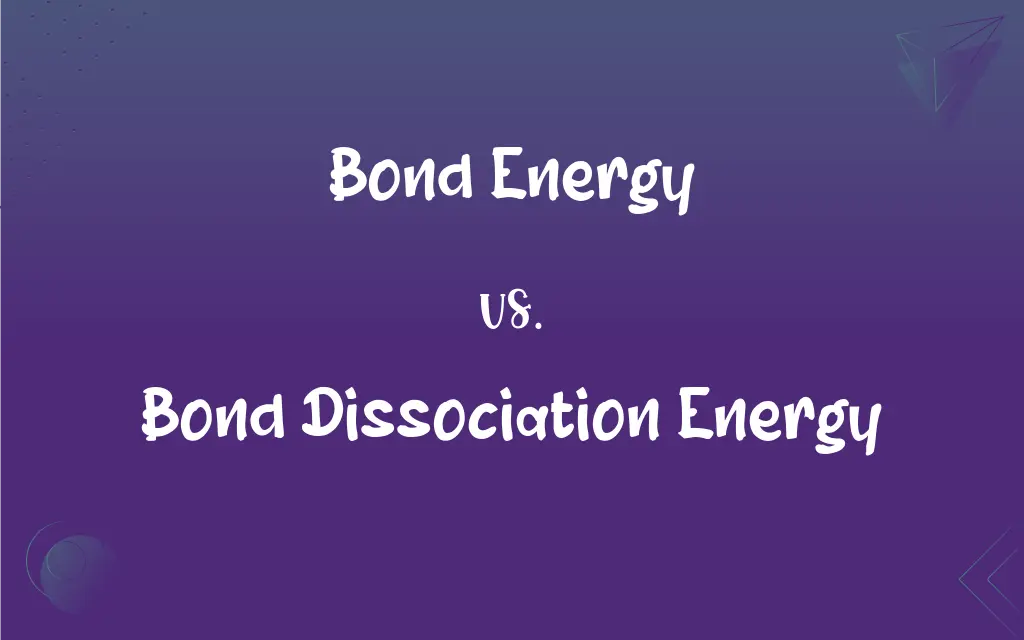Bond Energy vs. Bond Dissociation Energy: What's the Difference?
Edited by Aimie Carlson || By Harlon Moss || Updated on October 25, 2023
Bond energy is the average energy required to break a bond in a molecule, whereas bond dissociation energy is the energy for breaking a specific bond in a specific molecule.

Key Differences
Bond energy pertains to the average energy required to break a specific type of bond across various molecules. This means when one speaks of bond energy, they are often referring to a generalized value. On the contrary, bond dissociation energy zeroes in on the energy needed to cleave a particular bond in a distinct molecule.
Both bond energy and bond dissociation energy are measured in units of energy, often in kilojoules per mole (kJ/mol). However, bond energy provides an average value, calculated from several similar bonds in different molecules. Bond dissociation energy, in its specificity, can vary for different bonds in a single molecule.
For instance, considering a molecule with multiple similar bonds, like CH4 (methane), each C-H bond's dissociation might require slightly different energies. Bond energy would then be the average of these values. In contrast, bond dissociation energy would refer to the energy needed to break each C-H bond individually.
The distinction between bond energy and bond dissociation energy is vital in understanding and predicting chemical reactions. While bond energy offers a broader picture, suitable for general predictions, bond dissociation energy provides a precise value, crucial for specific reactions.
Comparison Chart
Definition
Average energy to break a specific type of bond across various molecules.
Energy to break a particular bond in a distinct molecule.
ADVERTISEMENT
Specificity
Generalized value.
Specific to a bond in a molecule.
Variation
Provides an average value for a type of bond.
Can vary for different bonds in the same molecule.
Utility
Used for general predictions about bond strength.
Offers precise energy values crucial for predicting specific reactions.
Example
Average energy to break C-H bonds in various hydrocarbons.
Energy to break the first C-H bond in methane.
Bond Energy and Bond Dissociation Energy Definitions
Bond Energy
Bond energy is measured in energy units like kJ/mol.
The bond energy for N≡N is about 945 kJ/mol.
ADVERTISEMENT
Bond Dissociation Energy
Bond dissociation energy is the energy to cleave a specific bond in a molecule.
The bond dissociation energy for the first H-H bond in H2 is unique.
Bond Energy
Bond energy is the mean energy needed to break a bond type in molecules.
The bond energy for O=O is higher than that for O-O.
Bond Dissociation Energy
Bond dissociation energy is essential for detailed chemical studies.
Understanding bond dissociation energy is crucial in enzyme catalysis studies.
Bond Energy
Bond energy is calculated as an average from multiple molecules.
The bond energy for C-H bonds considers various hydrocarbons.
Bond Dissociation Energy
Bond dissociation energy provides precise energy values.
For accurate reaction predictions, one might need the exact bond dissociation energy.
Bond Energy
Bond energy represents the strength of a bond type.
A higher bond energy indicates a stronger bond.
Bond Dissociation Energy
It's specific to a molecule and a particular bond within that molecule.
While methane has an average bond energy, the bond dissociation energy refers to breaking each C-H bond individually.
Bond Energy
Bond energy assists in predicting reaction feasibility.
A reaction might be favored if it breaks bonds with lower bond energy.
Bond Dissociation Energy
Bond dissociation energy can differ for bonds within the same molecule.
In methane, bond dissociation energy might vary for each C-H bond.
FAQs
What is bond energy?
Bond energy is the average amount of energy required to break one mole of a type of bond in a molecule in the gaseous state.
What is bond dissociation energy?
Bond dissociation energy is the energy required to break a specific bond in a molecule, producing fragments in their gaseous state.
Is bond dissociation energy always positive?
Yes, it's always positive because energy is required to break a bond.
Why are bond energies important in chemistry?
Bond energies help in predicting the heat of reactions and the stability of molecules.
What factors affect bond dissociation energy in complex molecules?
Factors include bond multiplicity, atomic size, electronegativity, resonance, and steric effects.
How is bond energy related to bond strength?
Higher bond energy indicates stronger bond strength.
Does bond length affect bond energy?
Yes, generally, shorter bonds have higher bond energies than longer bonds.
How does atomic size influence bond energy?
Smaller atoms tend to form stronger bonds with higher bond energies due to greater overlap of orbitals.
How do double and triple bonds compare in terms of bond energy?
Triple bonds generally have higher bond energies than double bonds, which in turn have higher bond energies than single bonds.
How does bond dissociation energy differ from bond energy?
While bond energy is the average energy required to break a specific type of bond across various molecules, bond dissociation energy refers to the energy required to break a specific bond in a particular molecule.
Do resonance structures affect bond dissociation energy?
Yes, resonance can distribute electron density over a molecule, potentially affecting the energy needed to break specific bonds.
How is bond dissociation energy measured?
It is usually measured using spectroscopic techniques or derived from enthalpy changes in thermochemical reactions.
Can a molecule have multiple bond dissociation energies?
Yes, different bonds within a molecule can have different bond dissociation energies.
Can bond energy and bond dissociation energy be equal for a molecule with only one type of bond?
Yes, for molecules with only one type of bond, the bond energy and bond dissociation energy can be the same.
How do these energies correlate with reaction spontaneity?
While they provide information on bond strengths, spontaneity also depends on factors like entropy and temperature. High bond energy doesn't always mean non-spontaneous reactions.
Does electronegativity difference affect bond strength?
Yes, bonds between atoms with large electronegativity differences (like ionic bonds) can have high bond energies, though other factors also play a role.
Is bond energy always positive?
Yes, bond energy is always positive because energy is required to break a bond.
Why is bond energy considered an average value?
Because a molecule can have multiple bonds of the same type with different energies, bond energy takes the average of these.
Which value is more specific to a particular molecule: bond energy or bond dissociation energy?
Bond dissociation energy, as it pertains to a specific bond in a specific molecule.
How are these energies used in chemical reactions?
They provide insights into the reactivity and stability of molecules. Higher energies indicate less stable bonds that are more likely to break.
About Author
Written by
Harlon MossHarlon is a seasoned quality moderator and accomplished content writer for Difference Wiki. An alumnus of the prestigious University of California, he earned his degree in Computer Science. Leveraging his academic background, Harlon brings a meticulous and informed perspective to his work, ensuring content accuracy and excellence.
Edited by
Aimie CarlsonAimie Carlson, holding a master's degree in English literature, is a fervent English language enthusiast. She lends her writing talents to Difference Wiki, a prominent website that specializes in comparisons, offering readers insightful analyses that both captivate and inform.
































































